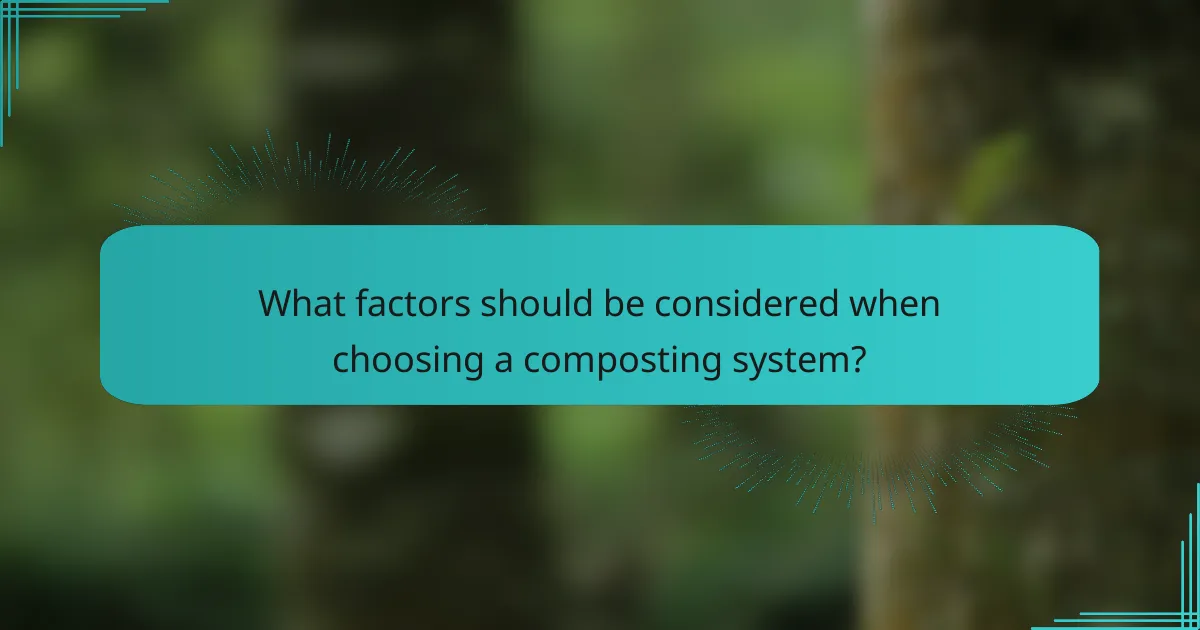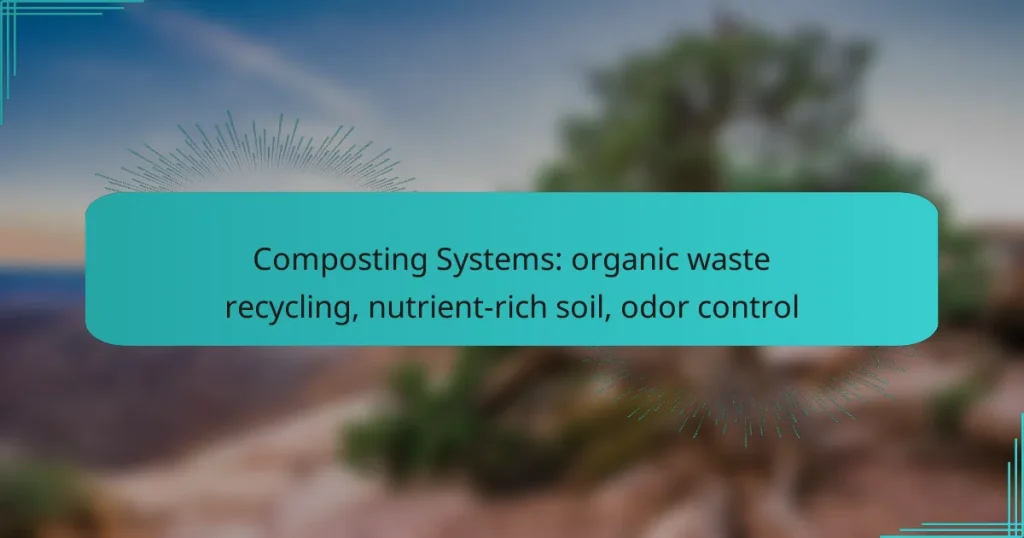Composting systems provide an efficient way to recycle organic waste, transforming it into nutrient-rich soil through natural decomposition. These systems are designed to effectively manage odors, making them suitable for various environments, from urban apartments to rural farms. By reducing landfill waste and enriching soil health, composting plays a vital role in sustainable waste management and promotes healthier plant growth.

What are the best composting systems in Australia?
The best composting systems in Australia include various methods suited for different needs and spaces, allowing for effective organic waste recycling. These systems can produce nutrient-rich soil while managing odor effectively, making them ideal for both urban and rural settings.
Worm composting systems
Worm composting, or vermicomposting, utilizes specific worm species to break down organic waste into rich compost. This method is particularly effective for kitchen scraps and small amounts of garden waste, producing nutrient-dense castings that enhance soil health.
To set up a worm composting system, choose a suitable bin with drainage holes and bedding material like shredded newspaper. Add worms and organic waste gradually, ensuring a balanced diet to maintain worm health. Avoid citrus and onion, which can be harmful to worms.
Bin composting systems
Bin composting systems are simple, enclosed structures that allow for the aerobic decomposition of organic materials. They can be made from wood, plastic, or metal and are suitable for backyard use, accommodating a variety of waste types including garden clippings and food scraps.
When using a bin composting system, layer green materials (nitrogen-rich) with brown materials (carbon-rich) to promote effective decomposition. Turn the pile regularly to aerate it and monitor moisture levels to prevent odors. Aim for a bin size of at least one cubic meter for optimal results.
Tumbler composting systems
Tumbler composting systems consist of a rotating drum that simplifies the mixing of compost materials. This method accelerates the composting process by providing aeration and even moisture distribution, making it ideal for those looking for quicker results.
To use a tumbler, fill it with a balanced mix of green and brown materials, then turn it every few days. This system is particularly effective for small to medium-sized households and can produce finished compost in a matter of weeks, depending on conditions.
In-vessel composting systems
In-vessel composting systems are enclosed units that control temperature, moisture, and aeration, allowing for rapid composting of organic waste. These systems are often used by businesses or larger households and can handle a variety of materials, including food waste and yard debris.
These systems can be more expensive but offer greater efficiency and odor control. Regular monitoring is necessary to maintain optimal conditions, and the compost produced is typically ready in a few weeks. Consider local regulations regarding the disposal of organic waste when choosing this system.
Community composting programs
Community composting programs involve collective efforts to manage organic waste at a local level, often supported by municipalities or community groups. These programs can help reduce landfill waste and create nutrient-rich compost for local gardens and parks.
Participating in a community composting program typically involves contributing organic waste to a shared composting site. This approach fosters community engagement and education about sustainable practices. Check with local councils in Australia for available programs and guidelines on participation.

How do composting systems recycle organic waste?
Composting systems recycle organic waste by transforming it into nutrient-rich soil through natural decomposition processes. This method not only reduces landfill waste but also enriches the soil, promoting healthier plant growth.
Microbial breakdown process
The microbial breakdown process is essential for composting, as microorganisms such as bacteria and fungi decompose organic materials. These microbes thrive on carbon-rich materials like leaves and wood chips, as well as nitrogen-rich materials like food scraps and grass clippings.
As these microorganisms consume the organic waste, they produce heat, which accelerates decomposition. Maintaining a balance of green (nitrogen-rich) and brown (carbon-rich) materials is crucial for effective microbial activity and efficient composting.
Carbon-to-nitrogen ratio importance
The carbon-to-nitrogen (C:N) ratio is a critical factor in composting, influencing the speed and efficiency of the decomposition process. An ideal C:N ratio ranges from 25:1 to 30:1, promoting optimal microbial activity.
Materials with high carbon content, such as dried leaves, should be balanced with nitrogen-rich materials like kitchen scraps. If the ratio is too high in carbon, decomposition slows down, while too much nitrogen can lead to odor issues and attract pests.
Role of aeration in composting
Aeration plays a vital role in composting by supplying oxygen to the microorganisms responsible for breaking down organic waste. Proper aeration helps maintain aerobic conditions, preventing the compost from becoming anaerobic, which can produce foul odors and slow decomposition.
To ensure adequate aeration, regularly turning the compost pile or using aeration tools can be beneficial. Aim to turn the pile every few weeks, allowing for better airflow and promoting a faster composting process.

What are the benefits of composting?
Composting offers numerous advantages, including the production of nutrient-rich soil, reduction of landfill waste, and improved soil health. These benefits contribute to sustainable waste management and enhance agricultural practices.
Nutrient-rich soil production
Composting transforms organic waste into nutrient-rich soil, often referred to as compost. This process involves the decomposition of kitchen scraps, yard waste, and other organic materials, which enriches the soil with essential nutrients like nitrogen, phosphorus, and potassium.
To create high-quality compost, maintain a balanced mix of green materials (like fruit scraps) and brown materials (like dried leaves). Aim for a carbon-to-nitrogen ratio of about 30:1 for optimal decomposition.
Reduction of landfill waste
Composting significantly reduces the amount of organic waste sent to landfills. By diverting food scraps and yard waste from landfills, composting helps lower methane emissions, a potent greenhouse gas produced when organic materials decompose anaerobically.
In many regions, composting can reduce landfill contributions by up to 30% or more. Engaging in composting not only supports waste reduction efforts but also fosters a culture of sustainability within communities.
Improved soil health
Compost enhances soil health by improving its structure, aeration, and moisture retention. Healthy soil supports beneficial microorganisms and earthworms, which contribute to a thriving ecosystem.
Incorporating compost into garden beds or agricultural fields can lead to increased crop yields and reduced need for chemical fertilizers. Regular application of compost can also help mitigate soil erosion and improve overall soil fertility.

How can composting systems control odors?
Composting systems can effectively control odors by managing the balance of materials and maintaining proper conditions. Key strategies include regulating moisture, incorporating carbon-rich materials, and ensuring adequate aeration.
Maintaining proper moisture levels
Moisture is crucial for composting, as it helps microorganisms break down organic matter. Aim for a moisture level similar to that of a damp sponge—too wet can lead to anaerobic conditions, while too dry slows decomposition.
To monitor moisture, regularly check the compost pile and add water if it feels dry. Conversely, if it becomes too wet, mix in dry materials like straw or shredded paper to absorb excess moisture.
Using carbon-rich materials
Incorporating carbon-rich materials, often referred to as “browns,” helps balance nitrogen-rich “greens” and reduces odors. Examples of carbon sources include dried leaves, wood chips, and cardboard.
A good rule of thumb is to maintain a carbon-to-nitrogen ratio of about 30:1. This balance promotes aerobic decomposition, minimizing foul smells associated with anaerobic processes.
Regular turning and aeration
Turning the compost pile regularly introduces oxygen, which is essential for aerobic bacteria that break down organic waste. Aim to turn the pile every few weeks to maintain airflow and prevent odor buildup.
Using a pitchfork or compost aerator, mix the materials thoroughly, ensuring that the center of the pile reaches higher temperatures. This not only helps control odors but also speeds up the composting process, typically reducing the time needed to produce finished compost.

What factors should be considered when choosing a composting system?
When selecting a composting system, consider available space, the type of organic waste you will process, and the maintenance requirements of the system. Each factor plays a crucial role in determining the efficiency and convenience of your composting efforts.
Available space
The amount of space you have will significantly influence your composting system choice. If you have a small yard or limited outdoor area, a compact compost bin or a worm composting setup may be ideal. For larger spaces, traditional compost piles or tumblers can accommodate more organic waste and produce compost more quickly.
Consider vertical composting options if space is tight. These systems can fit into smaller areas while still allowing for effective composting. Always ensure that your chosen system has adequate airflow and drainage to promote healthy decomposition.
Type of organic waste
The type of organic waste you plan to compost is essential for selecting the right system. Kitchen scraps, yard waste, and even certain paper products can be composted, but some systems handle specific materials better than others. For instance, a worm bin is excellent for kitchen scraps but may not be suitable for large branches or tough yard waste.
It’s also important to balance green materials (like fruit and vegetable scraps) with brown materials (like dried leaves and cardboard) to maintain proper composting conditions. Understanding what you will compost helps in choosing a system that can efficiently process your waste.
Maintenance requirements
Different composting systems come with varying maintenance needs. Some systems, like tumblers, require regular turning but are generally low-maintenance, while others, like traditional piles, may need more frequent monitoring and turning to ensure even decomposition. Assess how much time and effort you can realistically dedicate to maintaining your compost.
Consider the ease of access for adding materials and removing finished compost. Systems that are user-friendly can encourage consistent composting practices. Avoid systems that require excessive labor or complicated processes unless you are committed to regular upkeep.


